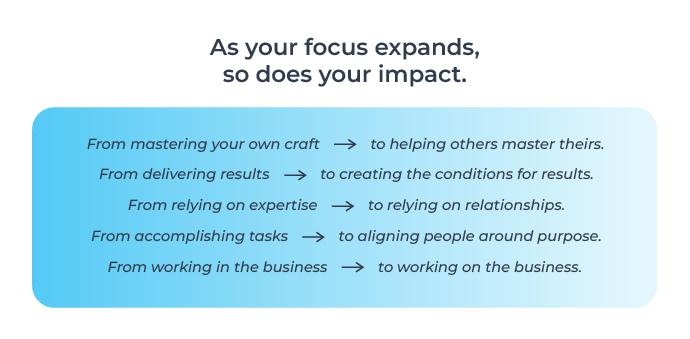Have you ever stepped into a leadership role only to realize that the strengths that once fueled your success aren’t working as well anymore?
If so, you’re not alone. The habits that make someone a top performer often become the same ones that hold them back during the transition from individual contributor to leader. That’s because doing the work and leading the work require two very different mindsets and skillsets.

For emerging leaders, this realization can be unsettling. For organizations, it’s a critical turning point. When your best performers hit that wall, how you support them determines whether they grow or go.
Research from CEB / Gartner suggests that up to 60% of new managers struggle or fail within their first two years, often because they aren’t adequately prepared for the transition from individual contributor to leader (this can mean missing goals, high turnover, or stepping out of the role). That high statistic isn’t a measure of inherent ability. It’s a red flag showing how vulnerable new leaders are when the organization doesn’t provide intentional development and support.
So, whether you’re the one making the shift or the one responsible for helping others make it, the question is the same: What do you do when the way you work stops working?
Key Differences Between “Doer” and Leader
1. From Personal Achievement to Enabling Others’ Success
In a “doing” role, success is measured by your own output. Speed, quality, and results. As a leader, the metric changes. Success now depends on how well your team performs and grows.
For individuals, that means moving from being the expert to becoming the coach.
For organizations, it means helping leaders develop the tools and confidence to let go of their old performance measures and embrace new ones.
2. From Control to Trust and Delegation
Doers are hands-on. They know every detail, every deliverable, and often feel most comfortable rolling up their sleeves to get things done. But leadership requires trust—building relationships, inspiring others, and empowering people to deliver in their own way. For the individual leader, that can feel uncomfortable at first.
The best leaders learn to let go. Because growth can’t happen when control takes center stage.
For organizations, it’s an opportunity to build a culture that rewards empowerment, not micromanagement.
3. From Short-Term Execution to Long-Term Vision
Doers focus on deadlines and to-do lists. Leaders zoom out. They set direction, clarify priorities, and connect the team’s daily work to the bigger picture.
Helping leaders make this shift takes more than a memo or management book. It takes coaching, reflection, and consistent reinforcement from the organization that this strategic lens is valued and expected.
Watch our Coffee with Kathy Episode on HPAs to learn more about what a leader’s priorities should look like.
4. From Technical Expertise to Emotional Intelligence
Technical skill might get you promoted. Emotional intelligence will determine how far you go.
Strong leaders recognize that empathy, influence, and communication drive performance more effectively than expertise alone. Navigating conflict, understanding personality dynamics, and inspiring confidence all start with emotional awareness—of yourself and your team.
Organizations that cultivate emotional intelligence don’t just develop better managers; they build stronger cultures that sustain long-term performance.
5. From Independence to Collaboration
As an individual contributor, results rely on your own effort. As a leader, success depends on your ability to collaborate and influence others.
Leaders grow by building trust across teams.
Organizations grow when they model that same collaborative spirit from the top down.
From Doer to Leader: A Case Study
When Haberfeld promoted Joe, one of their top-performing account managers, they recognized he was entering the critical transition from individual contributor to leader—a shift that requires new habits and support.
With support from the Accelerate Leadership Program, Joe learned to shift from managing tasks to developing people. He became more visible, more intentional, and more confident in empowering his team.
The impact went beyond Joe. His department grew stronger, engagement rose, and his story became a visible example of transformation inside the company. That’s the power of development done right. When one leader grows, the entire organization benefits.
Watch Joe’s full testimonial to see how his leadership transformation impacted his career and the Haberfeld team.
How to Help Leaders Make the Shift
Whether you’re stepping into a new leadership role like Joe or developing leaders within your organization, here are a few ways to create meaningful growth:
Ask Reflective Questions
- What habits am I (or are my leaders) relying on that no longer serve today’s role?
- Where are we defaulting to “doing” instead of “leading”?
- What opportunities exist for structured coaching or feedback?
Redefine Success
- Shift metrics from individual output to team outcomes.
- Celebrate shared wins.
- Encourage leaders to ask: “Did I create the conditions for others to succeed today?”
Delegate with Intention
- Empower leaders to give ownership, not just assignments.
- Encourage them to define the why behind the work, not only the how.
- Normalize learning through delegation. Even when outcomes differ from your approach.
Build Emotional Intelligence
- Model active listening and curiosity.
- Equip leaders to read their team’s emotional tone and adapt.
- Reinforce that empathy and clarity are as valuable as efficiency.
The Bottom Line
For leaders, growth begins with self-awareness. For organizations, growth begins with supporting that awareness through intentional development.
The first step is noticing when the old way stops working—often the first signal that you’re in the midst of the transition from individual contributor to leader. The next is redefining what success looks like (both individually and collectively). And the ongoing journey is practicing small, consistent shifts that multiply impact.
Because when leaders grow, teams thrive. And when teams thrive, organizations achieve results that last.
At Leadership Resources, we help leaders and organizations make these shifts intentionally by developing the mindset, habits, and accountability that drive measurable growth.
If your organization wants to better support the transition from individual contributor to leader, explore how the Accelerate Leadership Program can help.






